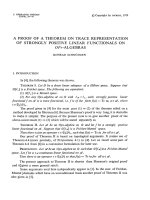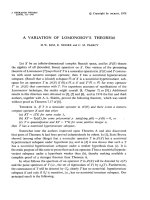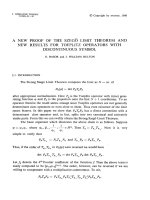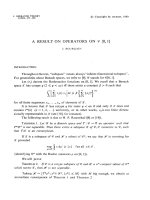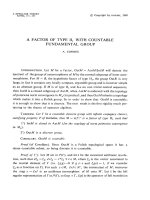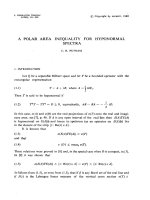Báo cáo toán học: "A Bijection between Atomic Partitions and Unsplitable Partitions" ppt
Bạn đang xem bản rút gọn của tài liệu. Xem và tải ngay bản đầy đủ của tài liệu tại đây (87.72 KB, 7 trang )
A Bijection between Atomic Partitions and
Unsplitable Partitions
Willia m Y.C. Chen
1
, Teresa X.S. Li
2
1,2
Center for Combinatorics, LPMC-TJKLC
Nankai University, Tianjin 300071, P.R. China
1
,
2
David G.L. Wang
3
3
Beijing International Center for Mathematical Research
Peking University, Beijing 100871, P.R. China
3
Submitted: Sep 3, 2010; Accepted: Dec 23, 2010; Published: Jan 5, 2011
Mathematics Subject Classification: 05A18, 05A19, 05E05
Abstract
In the study of the algebra NCSym of symmetric functions in noncommutative
variables, Bergeron and Zabrocki found a free generating set consisting of power sum
symmetric functions indexed by atomic partitions. On the other hand, Bergeron,
Reutenauer, Rosas, and Zabrocki studied another free generating s et of NCSym
consisting of monomial symmetric functions ind exed by unsplitable partitions . Can
and Sagan raised the qu estion of finding a bijection between atomic partitions and
unsplitable partitions. In this paper, we provide such a bijection.
1 Introduction
In their study of the algebra NCSym of symmetric functions in noncommutative variables,
Rosas and Sagan [5] introduced a vector space with a basis
{p
π
| π is a set partition},
where p
π
is the power sum symmetric function in noncommutat ive variables. Bergeron,
Hohlweg, Rosas, and Zabrocki [1] obtained the following formula
p
π|σ
= p
π
p
σ
,
where π|σ denotes the slash product of π and σ. It follows that, as an algebra, NCSym is
freely g enerated by p
π
with π atomic, see Bergeron and Zabrocki [3]. It should be noted
the electronic journal of combinatorics 18 (2011), #P7 1
that Wolf [6] showed that NCSym is freely generated by another basis. A combinatorial
characterization of the generating set of Wo lf has been found by Bergeron, Reutenauer,
Rosas, and Zabrocki [2]. More precisely, they introduced the notion of unsplitable parti-
tions and proved that the generating set of Wolf can be described as the set of monomial
symmetric functions in noncommutative variables indexed by unsplitable partitions.
Let [n] denote the set {1, 2, . . . , n}. Taking the degree into account, one sees that
the number of atomic partitions of [n] equals the number of unsplitable partitions of [n].
Recently, Can and Sag an [4 ] raised the question of finding a combinatorial proof of this
fact. The objective of this paper is to present such a proof.
2 The bijection
In this section we construct a bijection between the set of atomic par t itio ns of [n] and the
set of unsplitable part itio ns of [n].
Let us begin with an overview of terminology. Let X be a finite set of positive integers.
A partition π of X is a family {B
1
, B
2
, . . . , B
k
} of disjoint nonempty subsets of X whose
union is X. The subsets B
i
are called blocks of π. Without loss of generality, we may
assume that the blocks of a partition are arranged in the increasing order of their minimal
elements, and that the elements in each block are written in increasing order.
Let π be a partition of X and S ⊆ X. We say that σ is the restriction of π on S,
denoted by σ = π
S
, if σ is a partition of S such that any two elements lie in the same
block of σ if and only if they are in the same block of π. In other words, π
S
is obtained
from π by removing all elements that do not belong to S. For two positive integers i and
j with i < j, we use [i, j] to denote the set {i, i + 1, . . . , j}. For example, if
π =
{1, 3, 5, 6}, {2, 7, 9}, {4, 8, 10}
, (2.1)
then
π
[5,10]
=
{5, 6}, {7, 9}, {8, 10}
. (2.2)
Let Π
n
be the set of partitions of [n]. Assume that
π = {B
1
, B
2
, . . . , B
k
} ∈ Π
m
, σ = {C
1
, C
2
, . . . , C
l
} ∈ Π
n
.
The slash product of π and σ, denoted by π|σ, is defined to be the partition obtained by
joining the blocks of π and the blocks of the partition
σ + m = {C
1
+ m, C
2
+ m, . . . , C
l
+ m},
that is,
π|σ = {B
1
, B
2
, . . . , B
k
, C
1
+ m, C
2
+ m, . . . , C
l
+ m},
where C
i
+ m denotes the block obtained by adding m to each element in C
i
. It can
be seen that π|σ ∈ Π
m+n
. A partition π is said to be ato mic if there are no nonempty
partitions σ and τ such that π = σ|τ. Let A
n
be the set of atomic partitions of [n]. For
example, for n = 3 there a re two atomic partitions
{1, 3}, {2}
and
{1, 2, 3}
.
the electronic journal of combinatorics 18 (2011), #P7 2
The split product of π and σ, denoted by π ◦ σ, is given by
π ◦ σ =
{B
1
∪ (C
1
+ m), . . . , B
k
∪ (C
k
+ m), C
k+1
+ m, . . . , C
l
+ m}, if k ≤ l;
{B
1
∪ (C
1
+ m), . . . , B
l
∪ (C
l
+ m), B
l+1
, . . . , B
k
}, if k > l.
Clearly, π ◦ σ ∈ Π
m+n
. A partition is said to be splitable if it is the split product of two
nonempty partitions. Otherwise, it is said to be unsplitable. Denote by US
n
the set of
unsplitable partitions of [n]. For example, for n = 3 there are two unsplitable partitions
{1}, {2, 3}
and
{1}, {2}, {3}
.
To describe our bijection, we first notice that it is possible for a partition to be atomic
and unsplitable at the same time. For example, the par titio n
{1, 3, 7}, {2, 6}, {4, 5, 8}
is both atomic and unsplitable. Our bijection will be concerned with atomic partitions
that are splitable and unsplitable partitions that are not atomic. In other words, we shall
establish a bijection
ϕ: A
n
\US
n
−→ US
n
\A
n
.
Fo r the sake of presentation, let us introduce a notatio n. Let X = {x
1
, . . . , x
n
} be a
finite set of positive integers such that x
1
< · · · < x
n
. Suppose that π = {B
1
, B
2
, . . . , B
k
}
is a partition of X. Let r be the lar gest integer j such t hat
B
j
∪ B
j+1
∪ · · · ∪ B
k
= {x
t
, x
t+1
, . . . , x
n
}
for some t. The existence of such a n integer r is evident. We define
R(π) = {B
r
, B
r+1
, . . . , B
k
}.
Given the partition π =
{1, 3, 5, 6}, {2, 7, 9}, {4, 8, 10}
as in (2.1), we have
R(π
[5,10]
) =
{7, 9}, {8, 10}
. (2.3)
In the above notation, we see that π is atomic if and only if π = R(π).
We are now ready to present the map ϕ. Suppose that π = {B
1
, B
2
, . . . , B
k
} ∈
A
n
\US
n
. It consists of three steps.
Step 1. Let i be the smallest element in B
1
such that π = π
[i−1]
◦ (π
[i, n]
− i + 1). The
existence o f the element i is guaranteed by the condition that π is splitable.
Step 2. Let j be the smallest element in the underlying set of the partition R(π
[i, n]
). We
see that 2 ≤ i ≤ j ≤ n and R(π
[i, n]
) = π
[j, n]
.
Step 3. Set ϕ(π) to be the partition π
[j−1]
(π
[j, n]
− j + 1).
Fo r example, considering the partition given in (2.1 ) , we have i = 5. By (2.3), we get
j = 7 a nd thus
ϕ(π) =
{1, 3, 5, 6}, {2}, {4}, {7, 9}, {8, 10}
. (2.4)
Theorem 2.1 The map ϕ is a bijection from A
n
\US
n
to US
n
\A
n
.
the electronic journal of combinatorics 18 (2011), #P7 3
Proof. First, we claim that ϕ(π) ∈ US
n
\A
n
. Since 2 ≤ j ≤ n, both π
[j−1]
and π
[j, n]
are
nonempty partitions. This implies that ϕ(π) ∈ A
n
.
We next proceed to show that ϕ(π) is unsplitable. To this end, let
π
[j−1]
= {C
1
, C
2
, . . . , C
s
}, π
[j,n]
= {D
1
, D
2
, . . . , D
t
}.
Then
ϕ(π) = {C
1
, C
2
, . . . , C
s
, D
1
, D
2
, . . . , D
t
}.
Assume to the contrary tha t ϕ(π) is splitable, namely, there exists an element l ∈ C
1
such
that
ϕ(π) = ϕ(π)
[l−1]
◦ (ϕ(π)
[l, n]
− l + 1).
Since n belongs to some block D
h
, by the definition of the split product, we deduce that
C
p
∩ [l, n] = ∅, for each 1 ≤ p ≤ s. (2.5)
By the choice of i, we find that l ≥ i. Recall that π = {B
1
, B
2
, . . . , B
k
}. By the definition
of π
[j,n]
, we may assume that the block D
1
of π
[j,n]
is contained in some block B
r
of π. If
D
1
= B
r
, then the smallest element of B
r
is j. Therefore all elements in B
r+1
, B
r+2
, . . . , B
k
are larger than j. Now, by the choice of j, we deduce that
B
r
∪ B
r+1
∪ · · · ∪ B
k
= [j, n].
Consequently,
π = π
[j−1]
(π
[j, n]
− j + 1),
which contradicts the assumption that π is atomic. Hence we have D
1
= B
r
, and so
C
r
= B
r
\D
1
= ∅. Since D
1
is a block of the partition π
[i,n]
, it consists of all the elements
in B
r
that are la rger than or equal to i. In other words, each element in C
r
is less than i.
This yields that C
r
∩ [l, n] = ∅, a contradiction to (2.5). Thus we have proved the claim
that ϕ(π) ∈ US
n
\A
n
.
We now define a map
ψ : US
n
\A
n
−→ A
n
\US
n
,
and we shall show that ψ is the inverse of ϕ. Let σ = {B
1
, B
2
, . . . , B
k
} ∈ US
n
\A
n
.
Step 1. Let j be the smallest element in the underlying set o f the partition R(σ).
Step 2. If σ
[j−1]
is unsplitable, then set
ψ(σ) = σ
[j−1]
◦ (σ
[j, n]
− j + 1).
If σ
[j−1]
is splitable, then choose i to be the smallest element in B
1
such that
σ
[j−1]
= σ
[i−1]
◦ (σ
[i, j−1]
− i + 1). (2.6)
Let q = min{l | B
l
⊆ [i − 1]}, and let B
r
be the first block in the partition R(σ). If
2r − q − 1 ≤ k, then set
ψ(σ) = {B
1
, . . . , B
q−1
, B
q
∪ B
r
, . . . , B
r−1
∪ B
2r−q−1
, B
2r−q
, . . . , B
k
}.
the electronic journal of combinatorics 18 (2011), #P7 4
If 2r − q − 1 > k, then set
ψ(σ) = {B
1
, . . . , B
q−1
, B
q
∪ B
r
, . . . , B
q+k−r
∪ B
k
, B
q+k−r+1
, . . . , B
r−1
}.
First, we show that ψ is well-defined. For any σ ∈ US
n
\A
n
, we notice that in Step 1
of the above construction of ψ, the element j always exists. Moreover, we observe that
j ≥ 2 since σ is not atomic. By the choice of j, we have
σ
[j−1]
= {B
1
, B
2
, . . . , B
r−1
},
σ
[j, n]
= R(σ) = {B
r
, B
r+1
, . . . , B
k
}.
Since σ is unsplitable, we can always find the element q. Otherwise, if every block
B
1
, B
2
, . . . , B
k
contains an element in [i, n], by the assumption (2.6), we have B
p
∩[i, n] = ∅
for any 1 ≤ p ≤ k, and
min(B
1
∩ [i, n]) < min(B
2
∩ [i, n]) < · · · < min(B
k
∩ [i, n]).
This implies that
σ = σ
[i−1]
◦ (σ
[i, n]
− i + 1),
a contradiction to the fact that σ is unsplitable. This confirms the existence of the element
q. At this point, we still need to show that ψ(σ) ∈ A
n
\US
n
. It is clear from the above
construction that ψ(σ) is splitable. Fo r the case when σ
[j−1]
is unsplitable, it is easily
seen that ψ(σ) is a t omic. When σ
[j−1]
is splitable, since i ∈ B
1
and B
q
⊆ [i − 1 ], we
find that ψ(σ) is atomic. Thus we have shown that ψ(σ) ∈ A
n
\US
n
. Consequently, ψ is
well-defined.
It remains to show that ψ is indeed the inverse of ϕ, that is, ψ(ϕ(π)) = π for any
π ∈ A
n
\US
n
. As in t he construction of ϕ, we assume that i is the smallest element in
the first block of π such that
π = π
[i−1]
◦ (π
[i, n]
− i + 1),
and j is the smallest element in the underlying set of the partition R(π
[i, n]
). First we
notice that the element j chosen during the process of computing ϕ(π) coincides with the
element j defined when computing ψ(ϕ(π)), since
R(ϕ(π)) = ϕ(π)
[j, n]
= π
[j, n]
, (2.7)
by the definition of ϕ. Moreover, fro m Step 3 in the construction of ϕ, we see that
ϕ(π)
[j−1]
= π
[j−1]
. (2.8)
Now we need to consider two cases. If R(π
[i, n]
) = π
[i, n]
, i.e., i = j, then (2.8) implies
that ϕ(π)
[j−1]
= π
[i−1]
. Since π
[i−1]
is unsplitable by the choice of i, from (2.7) it follows
that
ψ(ϕ(π)) = ϕ(π)
[j−1]
◦ (ϕ(π)
[j, n]
− j + 1) = π
[i−1]
◦ (π
[i, n]
− i + 1) = π.
the electronic journal of combinatorics 18 (2011), #P7 5
If R(π
[i, n]
) = π
[i, n]
, that is, i < j, then we have
ϕ(π)
[j−1]
= π
[j−1]
= π
[i−1]
◦ (π
[i, j−1]
− i + 1).
This implies that ϕ(π)
[j−1]
is splitable. Recall t hat if the first block D
1
of π
[j,n]
is contained
in the block B
r
of π, then C
r
= B
r
\D
1
is a block of π
[j−1]
which consists of elements that
are smaller than i. So we may assume that
ϕ(π)
[j−1]
= {C
′
1
∪ C
′′
1
, C
′
2
∪ C
′′
2
, . . . , C
′
u−1
∪ C
′′
u−1
, C
u
, . . . , C
s
},
where
π
[i−1]
= {C
′
1
, C
′
1
, . . . , C
′
u−1
, C
u
, . . . , C
s
}
for some u ≤ s and
π
[i, j−1]
= {C
′′
1
, C
′′
2
, . . . , C
′′
u−1
}.
Since π = π
[i−1]
◦ (π
[i, n]
− i + 1) and π
[i, n]
= π
[i, j−1]
∪ π
[j, n]
, we deduce that u = r and
π = {C
′
1
∪ C
′′
1
, . . . , C
′
r−1
∪ C
′′
r−1
, C
r
∪ D
1
, C
r+1
∪ D
2
, . . .},
where π
[j, n]
= {D
1
, D
2
, . . . , D
t
}, and the last block of π depends on whether s − r + 1 ≤ t
or s −r + 1 > t. In other words, π can be recovered from ϕ(π) as the following procedure.
First, we combine the first block D
1
of ϕ(π)
[j, n]
with the block C
r
of ϕ(π)
[j−1]
. Then
we combine the second block of ϕ(π)
[j, n]
with C
r+1
, and so on. This process coincides
exactly with the construction of ψ(ϕ(π)) when ϕ(π)
[j−1]
is splitable. Thus we deduce that
ψ(ϕ(π)) = π. This completes the proof.
We conclude with some examples to illustrate the maps ϕ a nd ψ. Assume that
σ =
{1, 3, 5, 6}, {2}, {4}, {7, 9}, {8, 10}
which is the partition given in (2.4). It can be checked that ψ(σ) = π as given in (2.1).
In fact,
R(σ) =
{7, 9}, {8, 10}
and thus j = 7 is the smallest element in the underlying set of R(σ). Now,
σ
[j−1]
= {B
1
, B
2
, B
3
}
is splitable, where B
1
= {1, 3, 5, 6}, B
2
= {2} , and B
3
= {4} . In Step 2 of the map ψ,
i = 5 is the smallest element in B
1
such that
σ
[j−1]
= σ
[i−1]
◦ (σ
[i, j−1]
− i + 1).
Since B
2
is the first block of σ
[j−1]
that is contained in [i − 1], we get ψ(σ) = π.
Below is an example for t he case when ϕ(π)
[j−1]
is unsplitable. Let
π =
{1, 3, 5, 8}, {2, 6, 9}, {4, 7, 10}
.
the electronic journal of combinatorics 18 (2011), #P7 6
In Step 1 of the map ϕ, we have i = 5 and
π
[5,10]
=
{5, 8}, {6, 9}, {7, 10}
. (2.9)
Since R(π
[5,10]
) = π
[5,10]
, we see that j = 5 = i, and so
ϕ(π) =
{1, 3}, {2}, {4}, {5, 8}, {6, 9}, {7, 10}
. (2.10)
Conversely, let σ be the partition given in (2.10). It is easy to verify that the partition
R(σ) agrees with the partition given in (2.9). So we get j = 5 and
σ
[j−1]
=
{1, 3}, {2}, {4}
,
which is unsplitable. So we arrive at ψ(σ) = π.
Acknowledgments. We wish to thank the referee for helpful suggestions. This work
was supported by the 973 Proj ect, the PCSIRT Project of the Ministry of Science and
Technology, and the National Science Foundation of China.
References
[1] N. Bergeron, C. Hohlweg, M.H. Rosas and M. Zabrocki, Grothendieck bialgebras,
partition lattices, and symmetric functions in noncommutative variables, Electro n. J.
Combin. 13, 1 (2006), #R75.
[2] N. Bergeron, C. Reutenauer, M.H. Rosas and M. Zabrocki, Invariants and coinvariants
of the symmetric group in noncommuting variables, Canad. J. Math. 60, 2 (2008),
266–296.
[3] N. Bergeron and M. Zabrocki, The Hopf algebras of symmetric functions
and quasisymmetric functions in non-commutative variables are free and cofree,
arXiv:math.CO/0509265.
[4] M.B. Can and B.E. Saga n, Partitions, rooks, and symmetric functions in noncommut-
ing variables, arXiv:math.CO/1008.2950.
[5] M.H. Rosas and B.E. Sag an, Symmetric functions in noncommuting variables, Trans.
Amer. Math. Soc. 358, 1 (2006), 215–2 32.
[6] M.C. Wolf, Symmetric functions of non-commutative elements, Duke Math. J. 2
(1936), 626–637.
the electronic journal of combinatorics 18 (2011), #P7 7



